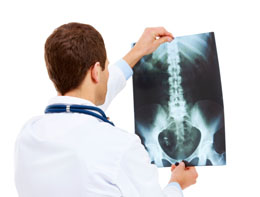A fracture in the pelvis may be the result of a trauma due to an accident or a bad fall. It is commonly seen in elderly. The upcoming Buzzle article deals with the causes, symptoms, and treatment of this condition. Also, some valuable information about proper diagnosis and recovery period is also provided here.

The pelvis comprises the bones at the hip consisting of three bones, viz., ilium, ischium, and pubis. The ligaments of these bones join the pelvis to a triangular bone known as the sacrum. The socket-like structure that forms the attachment for the hip joint is known as the acetabulum. A part of the digestive system and the reproductive system is located within the pelvic ring. It also serves as an attachment for various muscles of the legs. A fractured pelvis can prove fatal, and cause bleeding and organ damage. Therefore, it is necessary to take utmost care when this bone is fractured.
Causes
In children, especially teens, a pelvic fracture may be caused due to a sports injury. It may be a result of sudden muscle contractions, where a small piece of the bone is torn from the ischium by this muscle.
In elderly, this occurs due to osteoporosis. Hip fractures, sometimes, require hip replacement. An individual may fracture his or her pelvis due to a fall while standing or descending stairs. These do not harm the entire structure of the pelvis, but just a part or one of the bones is fractured.
Another major reason is an impact due to a car accident. Depending on the nature of the accident, the treatment and recovery may vary, a surgical treatment must be sought in extreme cases of pelvic fractures.
Symptoms
A fracture is often very painful. The pelvis has to be kept in traction in a particular position to avoid the pain. Numbness or a tingling sensation in the groin or legs is experienced. A person may have difficulty in urinating, standing, and walking as well. Sometimes bleeding of the internal organs of the pelvis may result due to a heavy impact. In females, this internal bleeding may result in bleeding from the vagina, or sometimes the rectum.
The types of fractures are graded based on a mechanism of injury. The gradations are as follows:
Grade I - Associated sacral compression on the side of the impact
Grade II - Associated posterior iliac fracture
Grade III - Associated contralateral sacroiliac joint fracture
Diagnosis
Initially, if an individual is complaining of pain in the pelvis, abrasions, contusions are examined for. Just like all other bone fractures, a pelvic fracture is diagnosed using X-rays of different angles. A CT scan helps in identifying the extent of injury to the pelvis. The blood vessels and nerves have to be examined for damage as well.
Treatment
Certain fractures such as that of athletes, heal with no surgical treatment. The person, however, has to use crutches or a walker for up to three months. Pain medication may also be prescribed by the physician. Sometimes, surgical treatment has to be opted for where an external fixator can be used to stabilize the pelvic area. These are like long screws, which are inserted from each side.
Recovery Period
Once the pelvis is stabilized it often heals well. In case of serious injuries due to accidents, the person may walk with a limp for some time, but if taken care of without subjecting it to a lot of stress, the fracture heals completely and the person is able to walk normally again. The recovery period may vary from 6 months to a year.
A fractured pelvis is quite painful, but you must remember that proper care and precautions is the only way out of this. Do not stress your legs a lot, and do as your physician says for a complete recovery.


 The pelvis comprises the bones at the hip consisting of three bones, viz., ilium, ischium, and pubis. The ligaments of these bones join the pelvis to a triangular bone known as the sacrum. The socket-like structure that forms the attachment for the hip joint is known as the acetabulum. A part of the digestive system and the reproductive system is located within the pelvic ring. It also serves as an attachment for various muscles of the legs. A fractured pelvis can prove fatal, and cause bleeding and organ damage. Therefore, it is necessary to take utmost care when this bone is fractured.
The pelvis comprises the bones at the hip consisting of three bones, viz., ilium, ischium, and pubis. The ligaments of these bones join the pelvis to a triangular bone known as the sacrum. The socket-like structure that forms the attachment for the hip joint is known as the acetabulum. A part of the digestive system and the reproductive system is located within the pelvic ring. It also serves as an attachment for various muscles of the legs. A fractured pelvis can prove fatal, and cause bleeding and organ damage. Therefore, it is necessary to take utmost care when this bone is fractured.